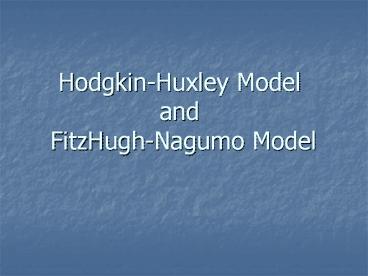Hodgkin-Huxley Model and FitzHugh-Nagumo Model - PowerPoint PPT Presentation
Title:
Hodgkin-Huxley Model and FitzHugh-Nagumo Model
Description:
Hodgkin-Huxley Model and FitzHugh-Nagumo Model Nervous System Signals are propagated from nerve cell to nerve cell (neuron) via electro-chemical mechanisms ~100 ... – PowerPoint PPT presentation
Number of Views:807
Avg rating:3.0/5.0
Title: Hodgkin-Huxley Model and FitzHugh-Nagumo Model
1
Hodgkin-Huxley Modeland FitzHugh-Nagumo Model
2
Nervous System
- Signals are propagated from nerve cell to nerve
cell (neuron) via electro-chemical mechanisms - 100 billion neurons in a person
- Hodgkin and Huxley experimented on squids and
discovered how the signal is produced within the
neuron - H.-H. model was published in Jour. of Physiology
(1952) - H.-H. were awarded 1963 Nobel Prize
- FitzHugh-Nagumo model is a simplification
3
Neuron
C. George Boeree www.ship.edu/cgboeree/
4
Action Potential
mV
Axon membrane potential difference V Vi
Ve When the axon is excited, V spikes because
sodium Na and potassium K ions flow through the
membrane.
_ 30
_ 0
V
10 msec
-70
5
Nernst Potential VNa , VK and Vr
Ion flow due to electrical signal
Traveling wave
C. George Boeree www.ship.edu/cgboeree/
6
Circuit Model for Axon Membrane
Since the membrane separates charge, it is
modeled as a capacitor with capacitance C. Ion
channels are resistors.
1/R g conductance
iC C dV/dt iNa gNa (V VNa) iK gK (V
VK) ir gr (V Vr)
7
Circuit Equations
- Since the sum of the currents is 0, it follows
that
where Iap is applied current. If ion conductances
are constants then group constants to obtain 1st
order, linear eq
Solving gives
8
Variable Conductance
g
Experiments showed that gNa and gK varied with
time and V. After stimulus, Na responds much more
rapidly than K .
9
Hodgkin-Huxley System
- Four state variables are used
- v(t)V(t)-Veq is membrane potential,
- m(t) is Na activation,
- n(t) is K activation and
- h(t) is Na inactivation.
In terms of these variables gKgKn4 and
gNagNam3h. The resting potential Veq-70mV.
Voltage clamp experiments determined gK and n as
functions of t and hence the parameter
dependences on v in the differential eq. for
n(t). Likewise for m(t) and h(t).
10
Hodgkin-Huxley System
11
110 mV
Iap 8, v(t)
1.2
m(t)
n(t)
40msec
h(t)
10msec
Iap7, v(t)
12
Fast-Slow Dynamics
m(t)
?m(v) dm/dt m8(v) m. ?m(v) is much smaller
than ?n(v) and ?h(v). An increase in v results
in an increase in m8(v) and a large dm/dt. Hence
Na activates more rapidly than K in response to a
change in v.
n(t)
h(t)
10msec
- v, m are on a fast time scale and n, h are slow.
13
FitzHugh-Nagumo System
and
I represents applied current, e is small and f(v)
is a cubic nonlinearity. Observe that in the
(v,w) phase plane which is small unless the
solution is near f(v)-wI0. Thus the slow
manifold is the cubic wf(v)I which is the
nullcline of the fast variable v. And w is the
slow variable with nullcline w2v.
14
Take f(v)v(1-v)(v-a) .
I0
I0.2
Stable rest state
Stable oscillation
w
w
v
v
15
References
- C.G. Boeree, The Neuron, www.ship.edu/cgboeree/.
- R. FitzHugh, Mathematical models of excitation
and propagation in nerve, In Biological
Engineering, Ed H.P. Schwan, McGraw-Hill, New
York, 1969. - L. Edelstein-Kesket, Mathematical Models in
Biology, Random House, New York, 1988. - A.L. Hodgkin, A.F. Huxley and B. Katz, J.
Physiology 116, 424-448,1952. - A.L. Hodgkin and A.F. Huxley, J. Physiol. 116,
449-566, 1952. - F.C. Hoppensteadt and C.S. Peskin, Modeling and
Simulation in Medicine and the Life Sciences, 2nd
ed, Springer-Verlag, New York, 2002. - J. Keener and J. Sneyd, Mathematical Physiology,
Springer-Verlag, New York, 1998. - J. Rinzel, Bull. Math. Biology 52, 5-23, 1990.
- E.K. Yeargers, R.W. Shonkwiler and J.V. Herod, An
Introduction to the Mathematics of Biology with
Computer Algebra Models, Birkhauser, Boston,
1996.






























